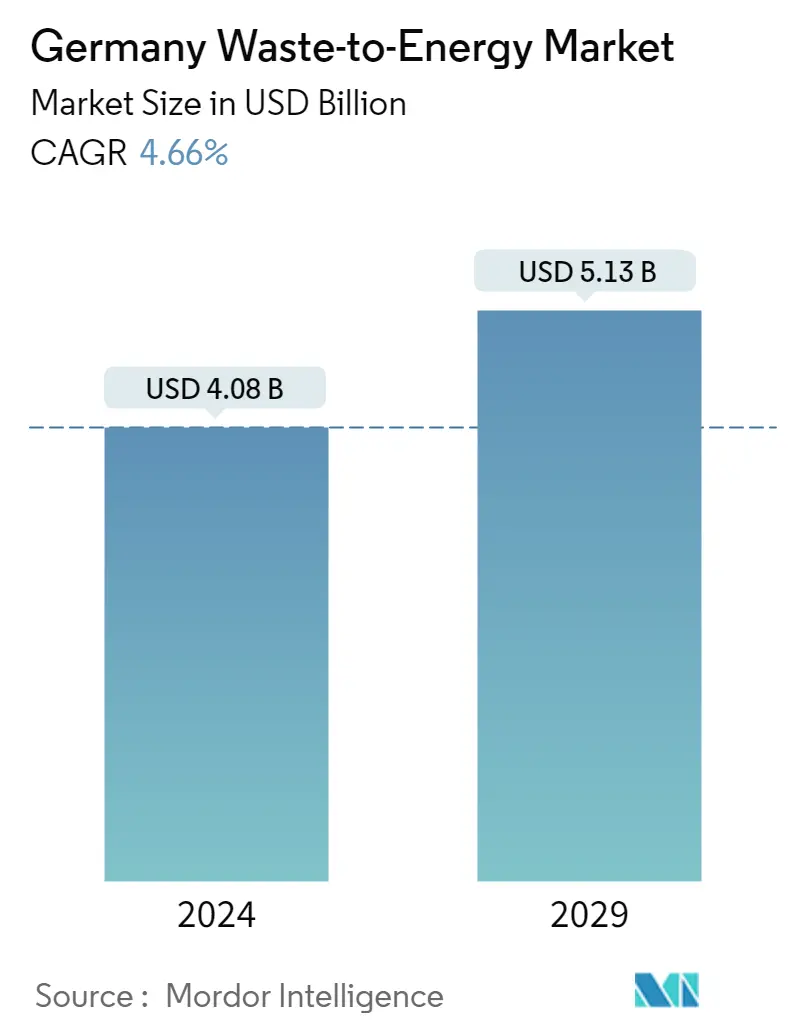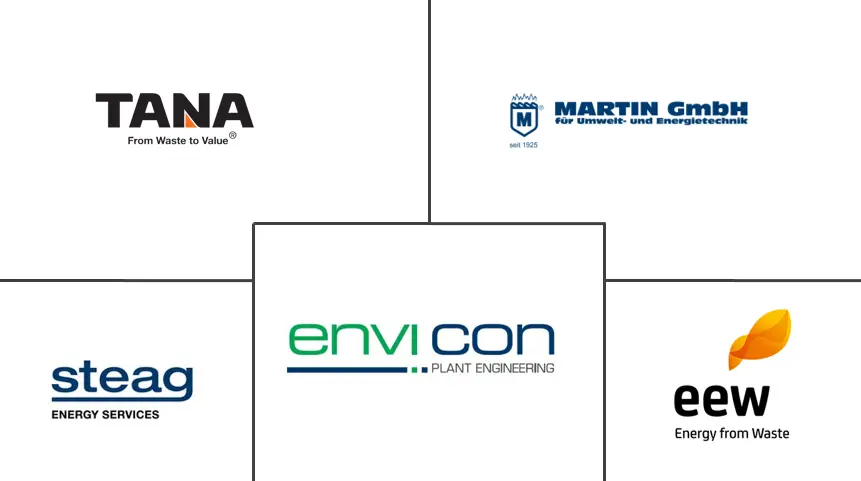Market Size of Germany Waste-to-Energy Industry

| Study Period | 2020 - 2029 |
| Base Year For Estimation | 2023 |
| Market Size (2024) | USD 4.08 Billion |
| Market Size (2029) | USD 5.13 Billion |
| CAGR (2024 - 2029) | 4.66 % |
| Market Concentration | Medium |
Major Players
*Disclaimer: Major Players sorted in no particular order |
Waste to Energy Germany Market Analysis
The Germany Waste-to-Energy Market size is estimated at USD 4.08 billion in 2024, and is expected to reach USD 5.13 billion by 2029, growing at a CAGR of 4.66% during the forecast period (2024-2029).
- With the high amount of waste generation becoming a pressing issue in the country, harnessing energy from waste is considered one of the most promising and sustainable solutions for the country's growing electricity and waste management needs. The increasing amount of waste generation, the growing concerns for its management to meet the need for sustainable urban living, and the increasing focus on non-fossil fuel sources of energy have been driving the adoption of the waste-to-energy market in the country.
- However, the recycling rate of waste in Germany remains among the highest in the world and also offers greater economic benefits than waste incineration, which has affected market growth in the country. Besides, the adoption of the resolution by the European Commission to turn Europe into a more circular economy and boost recycling of municipal solid waste to more than 65% by 2035 is expected to affect the market for incineration as well.
The emerging waste-to-energy technologies, such as Dendro Liquid Energy (DLE), which is four times more efficient in terms of electricity generation and has the additional benefit of no emission discharge or effluent problems at plant sites, are expected to create significant opportunities for the market players over the coming years.
Waste to Energy Germany Industry Segmentation
Waste is any substance or unwanted material resulting from human activity or process. Landfilling and thermal treatment are the most common waste disposal methods in high-income countries, while middle- and low-income countries mostly dispose of waste by open dumping. Waste-to-energy plants turn solid waste into energy, which would otherwise go to landfills. This is done by burning the waste and leaving behind a small amount of ash that can be reused as road or construction aggregate, with the remainder (such as toxic waste) being disposed of in a landfill. WTE plants reduce the burden on the existing landfills and help properly disposal of waste. By technology, the market is segmented into physical, thermal, and biological technology. For each segment, the market sizing and forecasts have been done on the basis of USD billion.
| Technology | |
| Physical | |
| Thermal | |
| Biological |
Germany Waste-to-Energy Market Size Summary
The waste-to-energy market in Germany is poised for growth, driven by the increasing generation of waste and the need for sustainable energy solutions. As the country grapples with high waste production, converting waste into energy presents a viable solution to meet its electricity and waste management demands. The focus on non-fossil fuel energy sources and sustainable urban living further propels the adoption of waste-to-energy technologies. However, Germany's high recycling rates and the European Commission's push towards a circular economy, aiming to enhance recycling rates, pose challenges to the market's expansion. Despite these challenges, emerging technologies like Dendro Liquid Energy offer promising opportunities for market players, potentially offsetting some of the constraints posed by recycling and incineration alternatives.
The market landscape is characterized by a moderate level of fragmentation, with key players such as Tana Oy, Martin GmbH, and EEW Energy from Waste actively participating. The construction of new waste-to-energy plants, such as the one in Geiselbullach, highlights ongoing investments in the sector. However, the market faces hurdles, including the limited energy efficiency of incineration plants and environmental concerns related to solid combustion residues. These factors, coupled with the historical shift from landfill disposal to recycling, suggest a complex market dynamic. Nonetheless, the ban on landfills and the need for alternative waste management solutions continue to drive demand for waste-to-energy facilities in Germany.
Germany Waste-to-Energy Market Size - Table of Contents
-
1. MARKET OVERVIEW
-
1.1 Introduction
-
1.2 Market Size and Demand Forecasts in USD billion, till 2028
-
1.3 Recent Trends and Developments
-
1.4 Government Policies and Regulations
-
1.5 MARKET DYNAMICS
-
1.5.1 Drivers
-
1.5.1.1 The High Amount of Waste Generation in the Country
-
1.5.1.2 The growing Focus on Non-Fossil Fuel Sources
-
-
1.5.2 Restraints
-
1.5.2.1 The Recycling Rate of Waste in Germany
-
-
-
1.6 Supply Chain Analysis
-
1.7 PESTLE Analysis
-
-
2. MARKET SEGMENTATION
-
2.1 Technology
-
2.1.1 Physical
-
2.1.2 Thermal
-
2.1.3 Biological
-
-
Germany Waste-to-Energy Market Size FAQs
How big is the Germany Waste-to-Energy Market?
The Germany Waste-to-Energy Market size is expected to reach USD 4.08 billion in 2024 and grow at a CAGR of 4.66% to reach USD 5.13 billion by 2029.
What is the current Germany Waste-to-Energy Market size?
In 2024, the Germany Waste-to-Energy Market size is expected to reach USD 4.08 billion.

